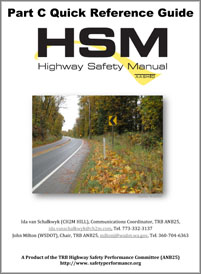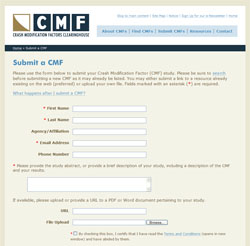CMF Update, Summer 2012
The Summer 2012 edition of CMF Update is the fifth edition of the Crash Modification Factors Clearinghouse e-newsletter. To subscribe to our newsletter, please visit http://www.cmfclearinghouse.org/newsletter_signup.php.
To view archived issues, please visit
http://www.cmfclearinghouse.org/newsletter.php.
New CMFs added to the Clearinghouse!
Over 100 crash modification factors (CMFs) have been added to the Clearinghouse recently. Collectively, the clearinghouse now contains over 3,700 CMFs for over 970 countermeasures.
Featured CMFs
Each edition CMF Update will feature CMFs of interest. The CMF Clearinghouse continually updates the online resource with new CMFs. Below is the list of this edition's featured CMFs.
Provide an auxiliary lane between an entrance ramp and exit ramp
CMF: 0.8
CRF: 20
Star Quality Rating: ![]()
Convert frontage road from two-way operation to one-way operation
CMF: 0.47
CRF: 57
Star Quality Rating: ![]()
Convert diamond interchange to Diverging Diamond Interchange (DDI) or Double Crossover Diamond (DCD)
CMF: 0.54
CRF: 46
Star Quality Rating: ![]()
Convert Pelican crossing or farside pedestrian signal to Puffin crossing
CMF: 0.81
CRF: 19
Star Quality Rating: ![]()
Install raised median
CMF: 0.86
CRF: 14
Star Quality Rating: ![]()
The CMF Clearinghouse will be updated on a regular basis to add recently developed and documented CMFs. New CMFs will be identified via a periodic review of published literature. In addition, the CMF Clearinghouse provides a mechanism for transportation professionals to submit their own CMFs to be considered for inclusion.
Featured Resource: National Highway Institute offers updated course on Science of Crash Modification Factors
This course provides participants with the knowledge and skills needed to critically assess the quality of Crash Modification Factors (CMFs). The course covers concepts underlying the measurement of safety and the development of CMFs, key statistical issues that affect the development of quality CMFs, key methodological issues that affect the development of quality CMFs, and the general and methodological issues and statistical thresholds used to recognize quality CMFs. This course combines self-paced material that will orient you to CMFs and what constitutes a quality CMF followed by a web-conference that will help you evaluate CMFs found in the CMF Clearinghouse. You will need access to both a telephone and internet connection to participate in the live web session.
Outcomes
Upon completion of the course, participants will be able to:
- Explain the concepts of Crash Modification Factors (CMFs) and the measurement of safety.
- List and describe important statistical issues that affect safety research.
- Describe and compare three methodologies for evaluating the safety effect of a countermeasure.
- Select the most appropriate CMF for a given application.
Target Audience
The professionals who would be most interested in completing this course are those who are responsible for identifying, recommending, selecting, and installing appropriate countermeasures to help reduce the number of crashes.
For more information, visit
https://highways.dot.gov/safety/data-analysis-tools/hsm/hsm-training-guide/4-training-course-descriptions
Or contact Karen Scurry at (609) 637-4207 or Karen.Scurry@dot.gov
Featured FAQ: How do I choose between CMFs in my search results that have the same star rating but different CMF values?
It's true that two or more CMFs for a particular countermeasure may have the same star rating but differing CMF values. It will be necessary for you to examine the information related to the applicability of the CMFs to determine how they differ. This could involve examining the brief data shown on the search results page (i.e., crash type, crash severity, roadway type, and area type) or looking at all the information about the CMFs by viewing the CMF details page for each one.
You should select the CMF that is most applicable to the situation in which you would like to apply the CMF (i.e., the characteristics associated with the CMF should closely match the characteristics of the scenario at hand). For example, CMFs often vary by crash type and crash severity. While it is useful to determine the change in crashes by type and severity, this should only be done when applicable CMFs are available for the specific crash type and severity of interest.
The figure below shows a snapshot of results for the countermeasure of "Installation of left-turn lane on single major road approach". You can see that the three CMFs listed in this figure all have 5-star ratings. However, the CMF values (0.65, 0.71, and 0.91) are all different.

From this initial view of the search results, it is relatively easy to tell the difference between the first CMF and the other two. Although all three are similar in crash type, crash severity, and roadway type, the first one (CMF of 0.65) is identified as being developed for a "Rural" area type, whereas the other two were developed for an "Urban" area type.
However, all information given on the search results page is identical for the second and third CMF. Therefore, it is necessary to examine the details of each CMF (by clicking on the CMF value to go to the CMF details page). When the details of each CMF are examined, it can be seen that the CMF of 0.71 is intended for stop-controlled intersections, and the CMF of 0.91 is intended for signalized intersections.
It may be the case that two CMFs are exactly the same with respect to crash and roadway applicability. In these cases, it will be necessary to examine some of the other fields related to how and where the CMF was developed, such as:
- Score details. The reviewers who established the star quality rating did so by giving scores of excellent, fair, or poor to five categories: study design, sample size, standard error, potential bias, and data source. Many CMFs in the Clearinghouse are accompanied by details of the scores behind the star rating as shown in the image below.

Clicking on the score details link will display a window showing the scores that the CMF received in each category. Users of the Clearinghouse will find it useful to examine the score details to compare two or more similar CMFs. For instance, although two CMFs may have received the same star rating, one may have a study design score of "Excellent" while the other is "Poor". It may be the case that a user may highly value study design and may use that category to decide between CMFs. Similarly, a user may prioritize some other category in their selection process and use that score to assist in selecting a CMF.
It is also useful to examine the fields in the CMF details pertaining to the scores, specifically sample size and standard error. It may be the case that two CMFs both received a score of "Excellent" for sample size, but one has a sample size of 1,000 while the other has a sample size of 3,000. Both of these sample sizes are large enough to qualify for an "Excellent" rating, however, all other factors being equal, the larger sample size would be preferred. Likewise, two CMFs may have both received a score of "Poor" for standard error, but one has a standard error of 0.75 while the other has a standard error of 0.90. In this case, the smaller standard error would be preferred. - Similarity in locality of data used. The fields for "Municipality", "State", and "Country" indicate the area(s) from which data were used in developing the CMF. Many agencies prefer CMFs that were developed in locations that are similar or nearby to their own area, for reasons of terrain, weather, and other characteristics. For example, a state department of transportation in a mid-western state may prefer using a CMF developed in Kansas over a CMF developed in West Virginia.
- Traffic volume range. The fields for "Major Road Traffic Volume" and "Minor Road Traffic Volume" indicate the range of traffic volumes that were used to develop the CMF. You should examine these fields to see which CMF has a traffic volume range that best fits your situation.
- Age of data. The field for "Date Range of Data Used" indicates the age of the data used in developing the CMF. Generally speaking, more recent data would be preferred (all other factors being equal). Studies conducted more recently typically use more advanced techniques, higher precision data, and have other advantages related to the progression of knowledge, data quality, and study methods that develop over time in the field of highway safety research. More recent data will also better reflect changes in vehicle fleet characteristics and technology.
Original study report. In addition to providing the citation of the study, the Clearinghouse provides a link, where possible, to the original study document for any CMF. This original document will typically be the final report or published article on the study that developed the CMF. A user of the Clearinghouse who is attempting to select between two similar CMFs will find it useful to refer to the original study report to understand the background of the CMF development. There may be details in the study report that would assist in the CMF selection process. Although the Clearinghouse contains extensive data for each CMF, it does not contain every detail from the study report. For example, the report may discuss details about the roadside character of the roads used in the CMF development. If the roadside character is significantly different from the roads in the user's jurisdiction, he or she may decide to select another CMF that was developed on roads with more similar roadside character to his or her jurisdiction.
For more answers to frequently asked questions, please visit http://www.cmfclearinghouse.org/faqs.php
Submit your CMFs to the Clearinghouse
The CMF Clearinghouse welcomes CMF study submissions to be included in its searchable database. Please use the provided form at http://cmfclearinghouse.org/pubsubmit.php to submit your study. Prior to submitting, please be sure to search before submitting a new CRF as it may already be listed. You may either submit a link to a resource already existing on the web (preferred) or upload your own file. Submissions might include published research studies that are not presented in the Clearinghouse, or state-specific CMFs that were developed as part of the HSIP.
Submit your Ideas for CMF Research Needs to the Clearinghouse
What CMF(s) are needed in your line of work but are not presented in the CMF Clearinghouse? The CMF Clearinghouse now has a feature on the website for submitting ideas or needs you have for CMFs that are not presented in the CMF Clearinghouse. Please use the provided form at http://www.cmfclearinghouse.org/research_submit.php to submit your CMF need. If there are published studies on that topic, the Clearinghouse team will endeavor to target those studies for review and inclusion in the Clearinghouse. If there are no published studies on that countermeasure, the idea will be retained as a future research need.



